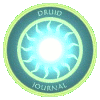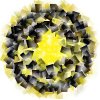First, let me reiterate exactly why it’s probable that the word “hand” used to mean something different.
 1. As explained in the previous post, the word for hand in the various languages descended from Proto-Indo-European are a very mixed bag, and do not derive from a single common ancestral word. The word for hand in PIE was probably “men”, but it is “handaz” in Proto-Germanic, “manus” in Latin, “lamh” in Proto-Celtic, and “cheir(o)” in Greek. Among the Slavic languages, they stopped mentioning the hand at all — to this day, most Slavic languages have no specific term for hand; they say “arm” (or “lower arm”) instead.
1. As explained in the previous post, the word for hand in the various languages descended from Proto-Indo-European are a very mixed bag, and do not derive from a single common ancestral word. The word for hand in PIE was probably “men”, but it is “handaz” in Proto-Germanic, “manus” in Latin, “lamh” in Proto-Celtic, and “cheir(o)” in Greek. Among the Slavic languages, they stopped mentioning the hand at all — to this day, most Slavic languages have no specific term for hand; they say “arm” (or “lower arm”) instead.
2. Why wasn’t the PIE word “men” retained in its daughter languages (except Latin)? The hypothesis is that “men” was a taboo word, a word of power, and people avoided it by using euphemisms. (Specifically, it was taboo because of its association with the sun god, who was imagined to have long or heavy hands, like the rays of the sun.)
3. A euphemism is some meaningful word (or phrase) in the language which is brought in to replace a word that cannot be spoken lightly. For example, “pushing up the daisies” is a euphemism for “dead”. The euphemism already has its own meaning, but when used as a euphemism, it takes on the meaning of the taboo word. And, notably, the original meaning of the euphemism is intended to be somehow reminiscent of the taboo word. For example, “pushing up the daisies” indicates being buried underground (and hence dead).
4. Therefore, the words used for hand in the daughter languages — “handaz”, “lamh”, and “cheir(o)” — already existed in PIE and already had their own meanings before being adopted as euphemisms for PIE “men”.
So — what did “hand” (or more accurately, “handaz”) mean before it was adopted as a euphemism?
The magnificent American Heritage Dictionary has a large section in the back which lists known (or conjectured) PIE root words. For example, if you look up “men” in the PIE roots appendix, you will find it there, along with a listing of some of its descendants that now live in English. Most of these come through Latin, and include “manipulate” and “manual”. (Interestingly, the PIE word “men” did survive in Germanic, but only with the specialized meaning “guarding hand”, and is the basis for the second element in the old names “Raymond”, “Edmund”, and “Osmund”, and possibly the word “mound”.)
Thus, using the AHD, one could in theory find the PIE word from which “handaz” is descended, and find out what it meant. But if you look up “handaz” in the appendix, you won’t find it. This is because “handaz” is from Proto-Germanic, not PIE. As PG broke away from PIE and became a different language in its own right, a cascade of sound changes (described in the formulation usually known as Grimm’s Law) altered the words significantly. For example, the PIE sound “k” became “h” in Proto-Germanic. Also, that “-az” ending — that’s not actually part of the root, that’s a grammatical suffix. Grammatical suffixes are endangered in most modern languages of Europe, and they are practically extinct in English; but one may still find them crouching in the shadowy corners of Romance sentences, and in German they still are an important part of the local ecosystem; while in Russian, as in classical Latin, they are so numerous as to be a positive nuisance. The “-az” is a suffix that corresponds to the Latin “-us”, found in “Augustus” and other nominative masculine singular individuals.
So to find the original PIE root of “handaz”, drop “-az” and change the “h” to “k”. The result is “kand”. Is there such a root listed in the AHD?
To the Dictionary!
kand-
Also kend-. To shine.
1. Suffixed (stative) form *kand–. CANDELABRUM, CANDELILLA, CANDENT, CANDESCENCE, CANDID, CANDIDA, CANDIDATE, CANDLE, CANDOR; INCANDESCE, from Latin “candre”, to shine.
2. INCENDIARY, INCENSE1, INCENSE2; FRANKINCENSE, from Latin compound “incendere”, to set fire to, kindle (in-, in; see en in Indo-European roots), from transitive *candere, to kindle.
[Pokorny kand- 526.]
Very interesting. It does not say that “kand” developed into “handaz” in Proto-Germanic. In fact, it does not say that “kand” descended into any Germanic language at all. But it does say that “kand” meant “to shine”, giving rise (through Greek) to the English words “candle” and “incandescent.” Remember the sun god, the god with the long hands. Is it possible that the AHD is missing the connection?
I suggest that the word did enter Germanic, but its meaning changed drastically. This change in meaning is what obscures the connection today.
The speakers of Proto-Germanic were looking for a word to serve as a euphemism for “men”. It would be perfectly natural for them to choose a word that reminded them of the sun god, just as “pushing up the daisies” reminds one of being underground. “Kand”, “to shine” , would be a great choice. Over thousands of years, and dozens of generations of children, the word “men” was used almost never, and the word “kand” — which changed eventually to “hand” — was used frequently. At last “men” was forgotten, along with the old god himself and the taboo. Only “hand” remained.
But taboos and gods from thousands of years ago can still quicken our spirits if we allow them to. Look at your hand now. Imagine that the fingers are rays spreading out from the sun. Just as the long hands of the sun reach out through space and gently paint life upon the surface of the earth, your hands give life and reality to your thoughts. The ancient Germans nicknamed their hands “brilliance”. Let your hands, and the work you do with them, be worthy of that word of power.
Footnote 1: for the curious, the same exercise can be done with the other euphemisms for “men” in Proto-Celtic, Greek, and so forth. For example, the Celtic “lamh” comes from the PIE root “pela”, meaning “flattening”, referring in particular to the flat of the hand. In English, this root (borrowed from Latin) is the basis for the word “palm”.
Footnote 2: I wondered whether “kindle” is also related to “candle” and “kand”. According to the excellent Online Etymology Dictionary , “kindle” derives from Old Norse “kynda”, dating approx. 1200 CE. But “kynda” itself is of unknown origin. It could not have come directly from PIE “kand” because of the sound changes mentioned before — anything starting with “k” in Old Norse must have started with “g” in PIE, so if “kynda” comes from PIE, in PIE it would have been “gunda” or perhaps “gundha” (I’m not sure whether the “d” would have been aspirated, and I don’t know how the vowel would have changed — I’m not actually an expert on this…) I can’t find evidence for such a PIE root. So four possibilities remain: (1) There was such a PIE root “gund-“, but it hasn’t been discovered; (2) the Old Norse simply made the word up; (3) the Old Norse borrowed the word from some local language, now lost to history; and (4) the Old Norse borrowed the word from Latin (recall from above that Latin “candere” meant “to kindle”). My money would be on (4). If that’s the case, then “kindle” is related to “candle”, PIE “kand”, and “hand”, though distantly.





Leave a comment